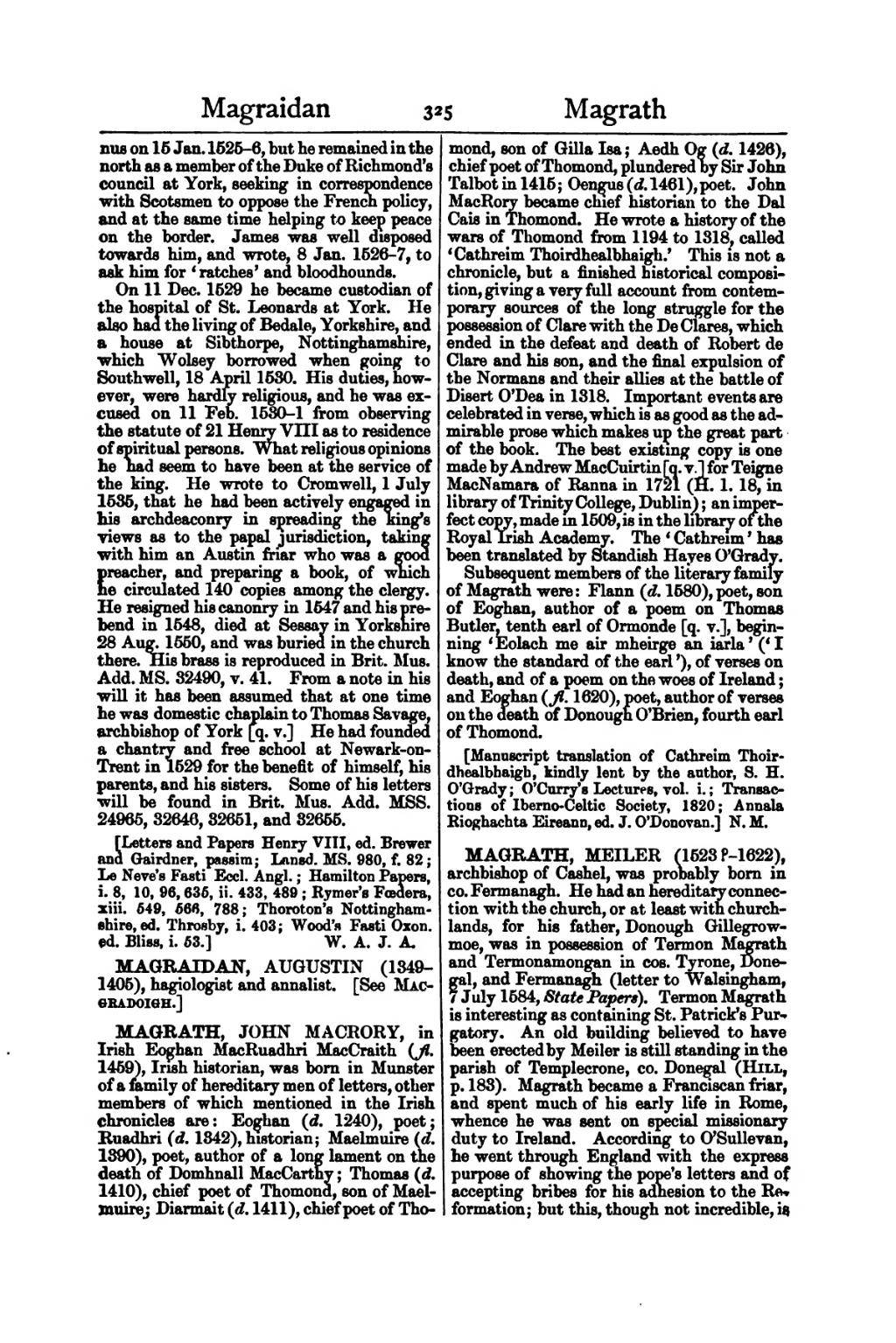nus on 15 Jan. 1525–6, but he remained in the north as a member of the Duke of Richmond's council at York, seeking in correspondence with Scotsmen to oppose the French policy, and at the same time helping to keep peace on the border. James was well disposed towards him, and wrote, 8 Jan. 1526–7, to ask him for ‘ratches’ and bloodhounds.
On 11 Dec. 1529 he became custodian of the hospital of St. Leonards at York. He also had the living of Bedale, Yorkshire, and a house at Sibthorpe, Nottinghamshire, which Wolsey borrowed when going to Southwell, 18 April 1530. His duties, however, were hardly religious, and he was excused on 11 Feb. 1530–1 from observing the statute of 21 Henry VIII as to residence of spiritual persons. What religious opinions he had seem to have been at the service of the king. He wrote to Cromwell, 1 July 1535, that he had been actively engaged in his archdeaconry in spreading the king's views as to the papal jurisdiction, taking with him an Austin friar who was a good preacher, and preparing a book, of which he circulated 140 copies among the clergy. He resigned his canonry in 1547 and his prebend in 1548, died at Sessay in Yorkshire 28 Aug. 1550, and was buried in the church there. His brass is reproduced in Brit. Mus. Add. MS. 32490, v. 41. From a note in his will it has been assumed that at one time he was domestic chaplain to Thomas Savage, archbishop of York [q. v.] He had founded a chantry and free school at Newark-on-Trent in 1529 for the benefit of himself, his parents, and his sisters. Some of his letters will be found in Brit. Mus. Add. MSS. 24965, 32646, 32651, and 32655.
[Letters and Papers Henry VIII, ed. Brewer and Gairdner, passim; Lansd. MS. 980, f. 82; Le Neve's Fasti Eccl. Angl.; Hamilton Papers, i. 8, 10, 96, 635, ii. 433, 489; Rymer's Fœdera, xiii. 549, 566, 788; Thoroton's Nottinghamshire, ed. Throsby, i. 403; Wood's Fasti Oxon. ed. Bliss, i. 53.]
MAGRAIDAN, AUGUSTIN (1349–1405), hagiologist and annalist. [See Macgradoigh.]
MAGRATH, JOHN MACRORY, in Irish Eoghan MacRuadhri MacCraith (fl. 1459), Irish historian, was born in Munster of a family of hereditary men of letters, other members of which mentioned in the Irish chronicles are: Eoghan (d. 1240), poet; Ruadhri (d. 1342), historian; Maelmuire (d. 1390), poet, author of a long lament on the death of Domhnall MacCarthy; Thomas (d. 1410), chief poet of Thomond, son of Maelmuire; Diarmait (d. 1411), chief poet of Thomond, son of Gilla Isa; Aedh Og (d. 1426), chief poet of Thomond, plundered by Sir John Talbot in 1415; Oengus (d. 1461), poet. John MacRory became chief historian to the Dal Cais in Thomond. He wrote a history of the wars of Thomond from 1194 to 1318, called ‘Cathreim Thoirdhealbhaigh.’ This is not a chronicle, but a finished historical composition, giving a very full account from contemporary sources of the long struggle for the possession of Clare with the De Clares, which ended in the defeat and death of Robert de Clare and his son, and the final expulsion of the Normans and their allies at the battle of Disert O'Dea in 1318. Important events are celebrated in verse, which is as good as the admirable prose which makes up the great part of the book. The best existing copy is one made by Andrew MacCuirtin [q. v.] for Teigne MacNamara of Ranna in 1721 (H. 1. 18, in library of Trinity College, Dublin); an imperfect copy, made in 1509, is in the library of the Royal Irish Academy. The ‘Cathreim’ has been translated by Standish Hayes O'Grady.
Subsequent members of the literary family of Magrath were: Flann (d. 1580), poet, son of Eoghan, author of a poem on Thomas Butler, tenth earl of Ormonde [q. v.], beginning ‘Eolach me air mheirge an iarla’ (‘I know the standard of the earl’), of verses on death, and of a poem on the woes of Ireland; and Eoghan (fl. 1620), poet, author of verses on the death of Donough O'Brien, fourth earl of Thomond.
[Manuscript translation of Cathreim Thoirdhealbhaigh, kindly lent by the author, S. H. O'Grady; O'Curry's Lectures, vol. i.; Transactions of Iberno-Celtic Society, 1820; Annala Rioghachta Eireann, ed. J. O'Donovan.]
MAGRATH, MEILER (1523?–1622), archbishop of Cashel, was probably born in co. Fermanagh. He had an hereditary connection with the church, or at least with church-lands, for his father, Donough Gillegrowmoe, was in possession of Termon Magrath and Termonamongan in cos. Tyrone, Donegal, and Fermanagh (letter to Walsingham, 7 July 1584, State Papers). Termon Magrath is interesting as containing St. Patrick's Purgatory. An old building believed to have been erected by Meiler is still standing in the parish of Templecrone, co. Donegal (Hill, p. 183). Magrath became a Franciscan friar, and spent much of his early life in Rome, whence he was sent on special missionary duty to Ireland. According to O'Sullevan, he went through England with the express purpose of showing the pope's letters and of accepting bribes for his adhesion to the Reformation; but this, though not incredible, is
